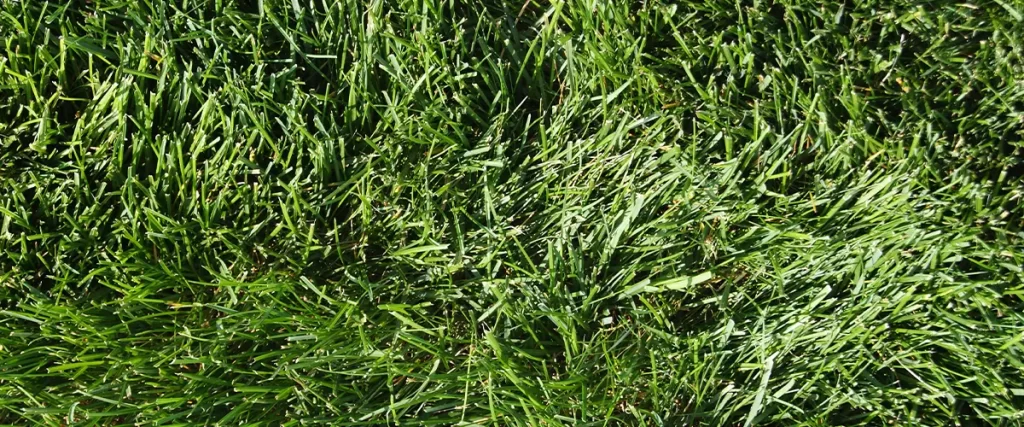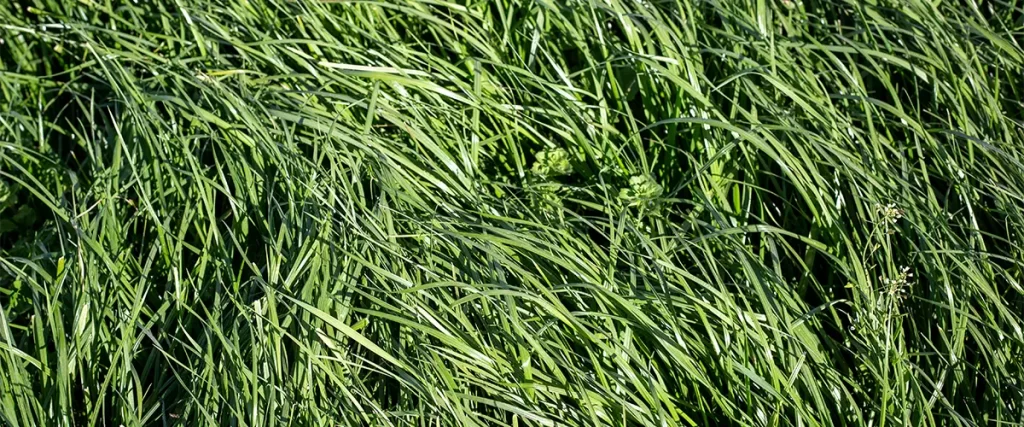Choosing the right grass for your lawn can feel like picking between two popular dishes – they’re both great, but your choice depends on what suits your taste and needs. Today, we’re comparing two top contenders: Kentucky Bluegrass vs Turf-Type Tall Fescue. Both are amazing, but they each shine in different ways. Let’s break it down!

What Is Kentucky Bluegrass?
Kentucky Bluegrass is like the luxury model of grasses – lush, soft, and green with a fine texture that feels incredible underfoot. It’s ideal for cooler climates and sunny areas, making it the go-to choice for that classic, manicured lawn look. Here’s what you should know:
- Texture: Fine, smooth, and soft to the touch.
- Growth: Spreads through underground stems called rhizomes, which help fill in bare spots.
- Climate: Thrives in cooler regions with plenty of sun.
- Water Needs: A bit of a water guzzler – it needs consistent hydration to stay lush.
What Is Turf-Type Tall Fescue?
Turf-Type Tall Fescue is the rugged, adaptable cousin of Kentucky Bluegrass. It’s thicker, tougher, and can handle a wider range of conditions, making it perfect for those who want a low-maintenance lawn. Here’s what makes it stand out:
- Texture: Coarser than Kentucky Bluegrass but still attractive. Newer varieties are softer than you’d expect.
- Growth: Grows in clumps, so it won’t naturally spread to cover bare areas.
- Climate: Handles heat, shade, and drought better than KBG.
- Water Needs: Less thirsty and can survive with infrequent watering.

Key Differences: Kentucky Bluegrass vs Turf-Type Tall Fescue
Here’s a side-by-side comparison to help you choose:
| Feature | Kentucky Bluegrass | Turf-Type Tall Fescue |
| Texture | Fine and soft | Thicker and slightly coarser |
| Climate Preference | Cooler climates | Adapts to heat, drought, and shade |
| Water Needs | High—needs regular watering | Low—drought-tolerant |
| Shade Tolerance | Moderate | Excellent |
| Maintenance | High—requires fertilizing and mowing | Low—less demanding |
| Spreading Ability | Spreads naturally via rhizomes | Grows in clumps, doesn’t spread |
Which Grass Handles Everyday Challenges Better?
When you’re deciding between Kentucky Bluegrass and Turf-Type Tall Fescue, it helps to think about how your lawn will be used and the kind of care it will need in different situations. Let’s explore some everyday scenarios and see how each grass type stacks up.
1. For Families with Kids or Pets
If your lawn doubles as a playground, durability is key. Imagine kids running around, setting up slip-and-slides, or dogs digging up their favorite spots. In these cases, Turf-Type Tall Fescue is the clear winner. It’s tougher and can handle more wear and tear without looking patchy or worn out.
- Example: If you’re hosting a summer barbecue with friends and family, Turf-Type Tall Fescue will bounce back quickly, even after heavy foot traffic. Kentucky Bluegrass might struggle a bit and could take longer to recover from damage.
2. Handling Extreme Weather
Kentucky Bluegrass thrives in cooler, wetter climates. Think of places where spring is long and summer is mild, like parts of the Midwest or Northeast. But when the weather gets extreme—whether it’s a scorching heatwave or a long drought – Kentucky Bluegrass tends to struggle. It can go dormant and turn brown without constant watering.
On the other hand, Turf-Type Tall Fescue is a survivalist. It can handle hot, dry summers with less water and still look green. That’s because it has deeper roots that help it tap into water reserves underground. If you live in an area prone to droughts or with inconsistent rainfall, Turf-Type Tall Fescue will save you time, water, and stress.
3. Dealing with Shade
Not all lawns get full sunlight all day. If your yard has trees, fences, or even nearby buildings casting shadows, shade tolerance becomes important. Turf-Type Tall Fescue shines in this department – it grows well in partial shade without thinning out.
Kentucky Bluegrass, on the other hand, prefers full sun and may thin out in shady areas. If your yard is half in the sun and half in the shade, you might consider mixing the two grasses or focusing on Turf-Type Tall Fescue for the shadier spots.
4. Seasonal Changes and Lawn Appearance
A beautiful lawn isn’t just about surviving the summer – it also needs to look good year-round. Kentucky Bluegrass is famous for its ability to recover quickly after winter. As soon as temperatures warm up, it greens up fast, giving your yard that “alive” look early in the season.
Turf-Type Tall Fescue also holds its color well through the seasons but may not bounce back from winter dormancy as quickly. However, its deep roots and overall toughness mean it’s less likely to suffer damage during freeze-thaw cycles.
Tips for Planting and Establishing Each Grass
Once you’ve chosen your grass type, the next step is planting it and helping it establish. Here are some tips for each grass type to ensure a healthy, lush lawn.
Planting Kentucky Bluegrass
- Seeding: Be patient! Kentucky Bluegrass seeds take about 14–21 days to germinate. If you’re starting from scratch, you’ll need to give it extra attention during this time.
- Sod: For faster results, consider sod. It gives you that instant lawn look and ensures even coverage.
- Soil Preparation: Kentucky Bluegrass loves rich, well-draining soil. Before planting, aerate your lawn and work in some compost to improve soil quality.
Planting Turf-Type Tall Fescue
- Seeding: Turf-Type Tall Fescue seeds germinate quickly, usually within 7–10 days. This makes it a great option if you need a lawn established in a hurry.
- Blends: Many seed mixes combine Turf-Type Tall Fescue with other grasses for added resilience. These are great for areas with varying conditions.
- Soil and Spacing: Since Tall Fescue grows in clumps, it’s important to seed evenly to avoid patchy areas. Use a spreader for uniform coverage.
Maintenance Hacks: Make Life Easier
Maintaining your lawn doesn’t have to feel like a chore. Here are some handy hacks and tips tailored to each grass type to save you time and effort.
For Kentucky Bluegrass
- Frequent Mowing: Since Kentucky Bluegrass grows quickly, plan to mow every 5–7 days during its peak growing season. Keep your mower blades sharp for a clean cut.
- Mulching: Use a mulching mower to return clippings to the soil, which provides extra nutrients and helps reduce the need for additional fertilizer.
- Weed Control: Kentucky Bluegrass is prone to weeds, so consider using a pre-emergent herbicide in early spring to stop weeds before they start.
For Turf-Type Tall Fescue
- Water Wisely: Since it’s drought-tolerant, water deeply but less often—about once a week. This encourages deep root growth and saves water.
- Aerate Annually: Over time, soil can become compacted, especially in high-traffic areas. Aerating once a year helps keep your Tall Fescue lawn healthy.
- Spot Seeding: For thin or damaged areas, overseed in the fall. Cooler temperatures and more consistent rainfall help seeds establish quickly.
Common Mistakes to Avoid
Even with the best intentions, it’s easy to make a few mistakes when caring for your lawn. Here’s what to watch out for:
- Overwatering Kentucky Bluegrass: Too much water can lead to shallow roots and make your lawn more vulnerable to disease. Stick to about 1–1.5 inches of water per week, even during hot spells.
- Skipping Fertilizer for Turf-Type Tall Fescue: Though it’s low-maintenance, Tall Fescue still benefits from occasional feeding. Neglecting fertilizer can lead to a thinner, less vibrant lawn.
- Not Considering Soil Type: Both grass types prefer slightly different soil conditions. Kentucky Bluegrass thrives in rich, loamy soil, while Tall Fescue can handle a wider range of soil types, including clay. Test your soil before planting to make sure it’s suitable for your chosen grass.
- Ignoring Thatch Build-Up: Thatch is a layer of dead grass that can accumulate over time. Too much thatch prevents water and nutrients from reaching the roots. Use a dethatching rake or hire a professional service to clear it out every few years.
Pros and Cons of Each Grass
Kentucky Bluegrass:
- Pros:
- Gorgeous, lush appearance.
- Soft texture, perfect for barefoot walks.
- Fills in bare spots over time.
- Cons:
- Needs frequent watering and fertilizing.
- Struggles in heat and drought.
- Slower to establish from seed.
Turf-Type Tall Fescue:
- Pros:
- Durable and low-maintenance.
- Tolerates heat, shade, and drought well.
- Great for high-traffic areas.
- Cons:
- Doesn’t spread—bare spots need reseeding.
- Thicker texture, which some may not prefer.
- Can grow faster, meaning more mowing during peak seasons.
How to Care for Each Grass
Kentucky Bluegrass:
- Watering: Needs consistent watering, about 1-1.5 inches per week.
- Fertilizing: Feed 2-4 times a year to keep it lush.
- Mowing: Keep it trimmed to 2-3 inches for the best look.
Turf-Type Tall Fescue:
- Watering: Deep but less frequent watering is ideal.
- Fertilizing: Apply fertilizer 2-3 times a year to maintain a healthy lawn.
- Mowing: Let it grow a bit taller, around 2.5-4 inches.
Frequently Asked Questions
1. Can I mix Kentucky Bluegrass and Turf-Type Tall Fescue?
Yes! Combining these grasses gives you the beauty of Kentucky Bluegrass and the durability of Turf-Type Tall Fescue. Many seed mixes are specifically designed for this purpose, so check your local garden center for the right blend.
2. Which grass grows faster?
Turf-Type Tall Fescue grows faster than Kentucky Bluegrass, especially when seeded. Kentucky Bluegrass takes longer to establish but spreads over time, filling in thin areas.
3. What’s the best grass for a shady yard?
Turf-Type Tall Fescue is your best bet. It handles shade better than Kentucky Bluegrass.
4. Which grass is better for high-traffic areas?
Turf-Type Tall Fescue is tougher and better for areas that see a lot of foot traffic, like backyards with kids or pets.
5. What’s the best option for hot, dry climates?
Turf-Type Tall Fescue is more drought-resistant and heat-tolerant, making it ideal for these conditions.

Which Grass Should You Choose?
Choosing between Kentucky Bluegrass and Turf-Type Tall Fescue ultimately depends on your lawn’s specific needs and how much time you’re willing to invest in maintenance.
If you dream of a soft, luxurious lawn and live in a cooler climate, Kentucky Bluegrass is the way to go. On the other hand, if you need a tough, low-maintenance option that thrives in challenging conditions, Turf-Type Tall Fescue is your best bet.
Whether you’re leaning toward the elegance of Kentucky Bluegrass or the resilience of Turf-Type Tall Fescue, having a professional team handle the job makes all the difference.
At Easy Green Landscaping, we specialize in creating lush, beautiful lawns tailored to your specific needs. From seeding to care tips, we’re here to make your lawn the envy of the neighborhood.
Contact us today at (303) 766-3304 to schedule a consultation and get started on your dream lawn!
